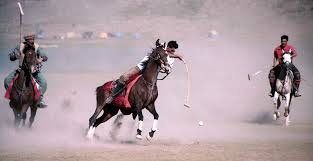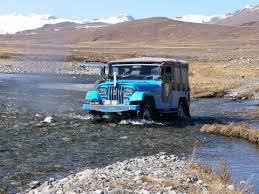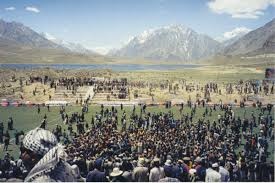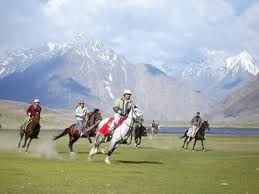The origins of polo in Central Asia go back as far as the sixth century BC when it was a training game for the king's cavalry units. To those warlike tribesmen who played the game with as many as one hundred players a side, it was a miniature battle. Twelve centuries later, in the sixth century A.D, polo had become the national game of Persia. From Persia, the game spread to Arabia, then to Tibet, China and Japan.

It was a dangerous game in those days: in China in a year AD910, the Emperor Apao Chi's favourite relative was killed in the game, and he ordered the beheading of all the players! The word 'polo' comes from the Tibetan word 'polo' meaning 'ball game', but the ball they played with was possibly not the one we know today.
Yet more centuries later in the 1930s, in the Hindu Kush highland between Chitral and Gilgit, the Mir of Moskuj decided to promote peaceful relations by holding a polo match.The British Resident of the time, Colonel Evelyn Hey Cobb, who was a keen polo player, suggested holding the tournament in the Shandur Pass which is 11000ft (3700m) above sea level, where he could realize his dream of playing polo by moonlight.Perched dramatically on the ridge between 'heaven and hell', the Shandur pass polo ground is surrounded by some of the most spectacular mountain scenery in the world.

The rules of those early between Chitral and Gilgit were ancient; the game lasted an hour with a ten-minute break between two thirty-minute chukkars ( chukkar = an Urdu word which means a round of play in a polo game ). The polo ground, the same one as is used to day, is smaller in both breath and width than a conventional modern ground, and it is surrounded by a stone wall, frequently the cause of serious injury to fallen players, both back in the 1930s, and now.
Every year, injuries and even deaths are recorded amongst the many thousands of spectators who make their way along the treacherous route to the polo ground . From Chitral, even in a jeep, the drive is nine hours; from Gilgit, it is thirteen hours. This trek on foot along the vertiginous, narrow, stony paths is, at best, nerve-wracking.
The journey is dangerous for the ponies, too, which also have to make the perilous five-day trek. They are Pakistani-bred Punjabi and Afghan Badakshani ponies bred from Himalayan mountain ponies and English thoroughbreds: a powerful breed indeed.

As animals and spectators finally reach the polo ground, the Hindu Kush land scape is transformed. A sea of tents spills over the area with people camping out in temperatures which range from -10 (degree centigrade )at night to +40(degree centigrade)during the day, and spectators cover every possible vantage point.The whole area is a vibrant crush of excited people, police in combat gear, armed soldiers, pedlars, entertainers, food and craft stalls. As the start of the tournament nears, the tension rises even higher.

The tournament itself is fought hard and extremely fast, and the ponies are ridden with supremely impressive skill at full speed.The ball is cracked with tremendous force, and not just the ball, but opponents' arms and shoulder,too. Once the game is over, the police cannot stop waves of jubilant fans flooding the polo ground to join in with those carrying their victorious heroes from the ground high on their shoulders, and with the victory dances.

After the victory and wild celebrations, spectators and players must once more face reality. Next summer it will happen all over again.




